Журнальный клуб Интелрос » Joint Force Quarterly » №82, 2016
During the Cuban Missile Crisis of 1962, President John F. Kennedy weighed a number of factors to assess the potential effectiveness of U.S. actions to deter the Soviets from further deployment of medium-range nuclear missiles in Cuba. Kennedy realized that an existing missile gap gave the United States an assured second-strike capability, but Soviet missiles in Cuba would make the consequences of a Soviet first strike much costlier. For example, U.S. extended-deterrence strategies would be at risk, which could suggest that the United States might not risk nuclear war if the Soviets subsequently assaulted Berlin. Although Kennedy’s greatest fear was the potential for human error and accidental escalation during the standoff, he gained insight into Soviet Premier Nikita Khrushchev’s risk tolerance after receiving a rambling four-part cable from the seemingly stressed Soviet leader.1In the end, it was the rational consideration of these factors from both his and Khrushchev’s perspectives that allowed Kennedy to assess relative resolve and select actions that would control escalation.
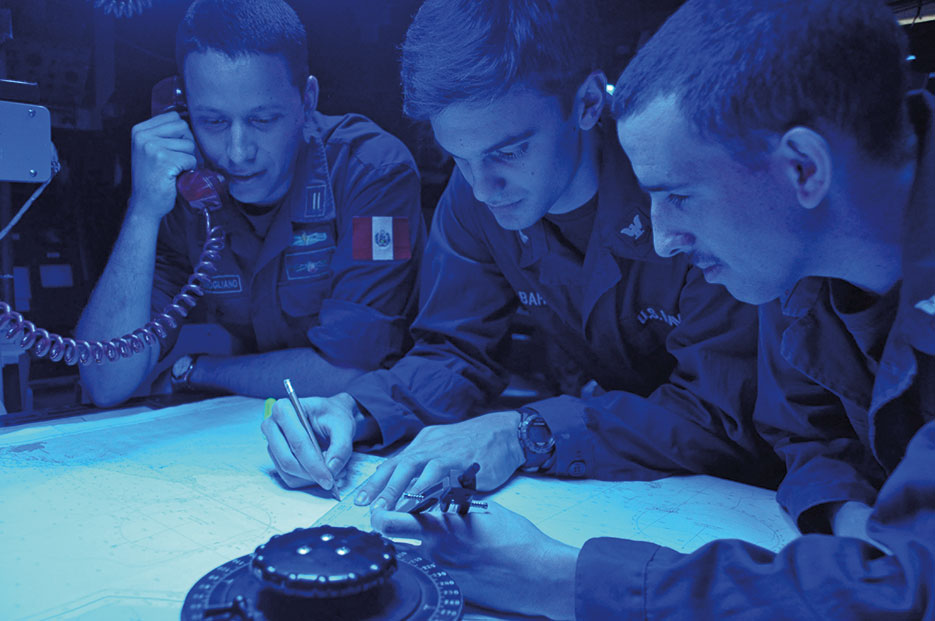
Two U.S. Navy Sailors and Peruvian sailor confirm position of simulated enemy destroyer in combat information center aboard guided-missile frigate USS Rentz during wargames as part of annual UNITAS multinational maritime exercise, off coast of Colombia, September 14, 2013 (U.S. Navy/Corey Barker)
No rubric currently exists, however, for national leaders to make these time-constrained decisions in ambiguous strategic environments. Decisionmakers may lack the time to identify and weigh the relevant factors associated with a strategic crisis. This article describes how the U.S. Naval War College uses wargaming to help measure factors associated with strategic deterrence decisionmaking by emulating notional crises between nuclear-capable adversaries. As a result, wargaming not only provides decisionmaking experience for those who participate but also examines the suitability of various deterrence strategies through analysis of the decisions made and the perceptions that influence those decisions.
Maintaining a secure and effective nuclear deterrent remains the highest priority mission for U.S. military forces.2However, assessing the effectiveness of strategic deterrent options can prove challenging due to the difficulty of measuring deterrence as a strategy. Joint doctrine defines deterrence as the prevention of adversary action by the existence of a credible threat of unacceptable counteraction that results in a belief that the cost of action outweighs the perceived benefits.3 Deterrence can also be described as the manipulation of an adversary’s estimation of the costs and benefits of taking action.4 Abstract concepts such as prevention and manipulation inhibit an objective examination using empirical methods.
Deterrence has a behavioral science dimension to it, as “deterrence, more than anything else, is psychological.”5Unfortunately, there are few historical examples, such as the Cuban Missile Crisis, of how leaders think during a strategic crisis between nuclear-capable adversaries. Therefore, wargaming provides a suitable means to research deterrence.
Gaming is a means to gain useful experience and information in advance of an actual commitment; of experimenting with forces and situations that are too remote, too costly, or too complicated to mobilize and manipulate; and of exploring and shaping the organizations and systems of the future. When, as in atomic warfare, there are no precedents, no historical examples to furnish guidelines, wargaming creates its own history of artificial wars.6
While wargaming provides a laboratory to experiment with deterrence strategy, the measurement device for deterrence remains elusive. Thus, instead of measuring deterrence directly, a better approach may be viewing deterrence as a key to managing an enemy’s intentional escalation, such that an enemy is discouraged “from deliberately escalating a conflict by convincing that enemy that the costs of such actions will outweigh the benefits that may be accrued through escalation.”7 Through analysis of escalation dynamics using wargaming, the U.S. Naval War College has attempted to provide a framework for measuring strategic deterrence effectiveness.
Measuring Escalation and Resolve
At the U.S. Naval War College, the War Gaming Department has examined strategic deterrence through the lens of escalation and resolve. Escalation can be viewed as “an increase in the intensity or scope of conflict that crosses threshold(s) considered significant by one or more of the participants.”8 From this perspective, escalation can be measured as an event. But defining escalation as a distinct event fails to consider either the intent of action or “any type of conflict, where adversaries typically strive to gain a comparative advantage.”9 In any case, escalation as a concept tends to be easier to measure than deterrence, but still proves challenging.
Game theory can be used to examine deterrence with relative resolve as a key variable for measuring escalation.Brinkmanship is a contest of resolve and a competition in taking risks. Resolve is defined as a state’s willingness to run the risk of disaster. But relative resolve must also consider the adversaries’ resolve as well as one’s own, where “a state’s beliefs about the resolve of its adversaries are important, but so are its beliefs about its adversary’s beliefs.”10
To conduct this examination, resolve needed to be modeled and subsequently measured. As depicted in figure 1, we assessed resolve using a simple model comprised of three components: stakes, credible capabilities, and risk tolerance. The stakes represent the strategic objectives and national interests of an actor, either challenger or defender, in a crisis. Credible capabilities represent the relevant factors of time, space, and forces for either actor that enhance the perception that escalation is possible. Risk tolerance represents the inherent aggressiveness or boldness of either actor.
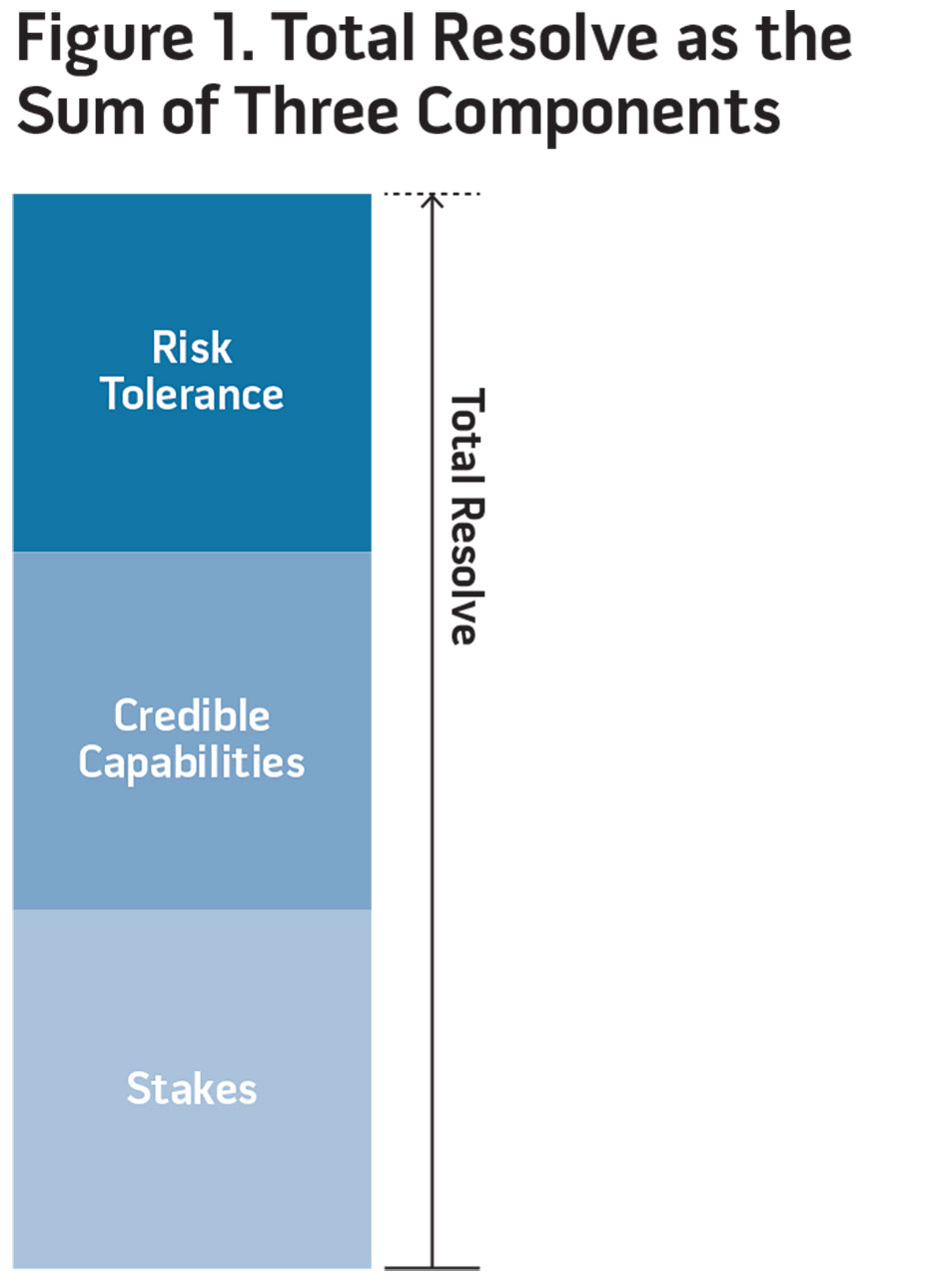
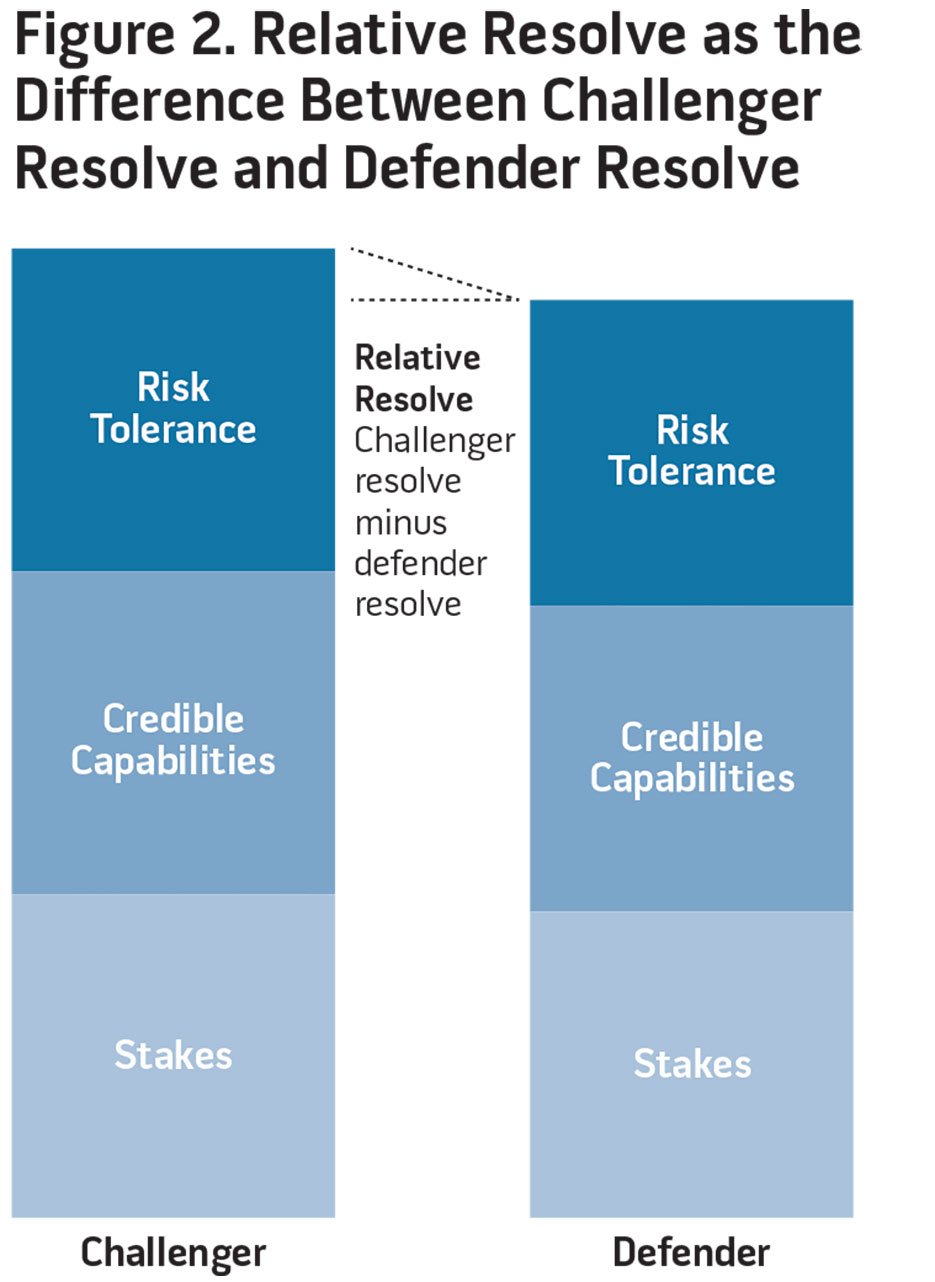
Understanding one’s own resolve is important, as is understanding that of the adversary. However, it is the comparison of the two resolves that matters. Relative resolve pertains to how an actor perceives the other actor’s resolve relative to its own, and is calculated as the difference between the challenger resolve and the defender resolve. Because resolve is an additive function of the three components, a defender may perceive itself as having greater stakes and more credible capabilities, but less risk tolerance, than the challenger. In this case, as depicted in figure 2, the challenger has a greater resolve relative to the defender.
The relative resolve is calculated as the challenger resolve minus the defender resolve. Figure 3 illustrates the relationship between relative resolve and escalation. When relative resolve is equal to zero, any escalation by the challenger could result in a reciprocal escalation by the adversary, as perceived by the challenger. With perfect information, a game theory perspective would suggest that escalation would not occur because each escalation by a challenger would face a likely reciprocal escalation by the defender.11
In a situation where the challenger resolve is perceived as greater than the defender resolve, the relative resolve is greater than zero. As depicted in figure 4, the slope of the line for relative resolve slides up on the graph, leaving a gap below the slope on the vertical access as a prime environment for “salami tactics.” This term refers to a strategy where a challenger can escalate gradually, slicing off small parts of its objectives one at a time, with little expectation of defender retaliation. Thomas Schelling described salami tactics in simple terms:
“Salami tactics,” we can be sure, were invented by a child. . . . Tell a child not to go in the water and he’ll sit on the bank and submerge his bare feet; he is not yet “in” the water. Acquiesce, and he’ll stand up; no more of him is in the water than before. Think it over, and he’ll start wading, not going any deeper; take a moment to decide whether this is different and he’ll go a little deeper, arguing that since he goes back and forth it all averages out. Pretty soon we are calling to him not to swim out of sight, wondering whatever happened to all our discipline.12
When a challenger escalates a small amount, figure 4 suggests the defender will acquiesce and a new status quo emerges. However, if the defender perceived the relative resolve as equal, such as depicted in figure 3, then a corresponding escalation could be expected by the defender. Therefore, “only if both the challenger and defender are sufficiently confident that their adversaries are irresolute will there be a crisis.”13

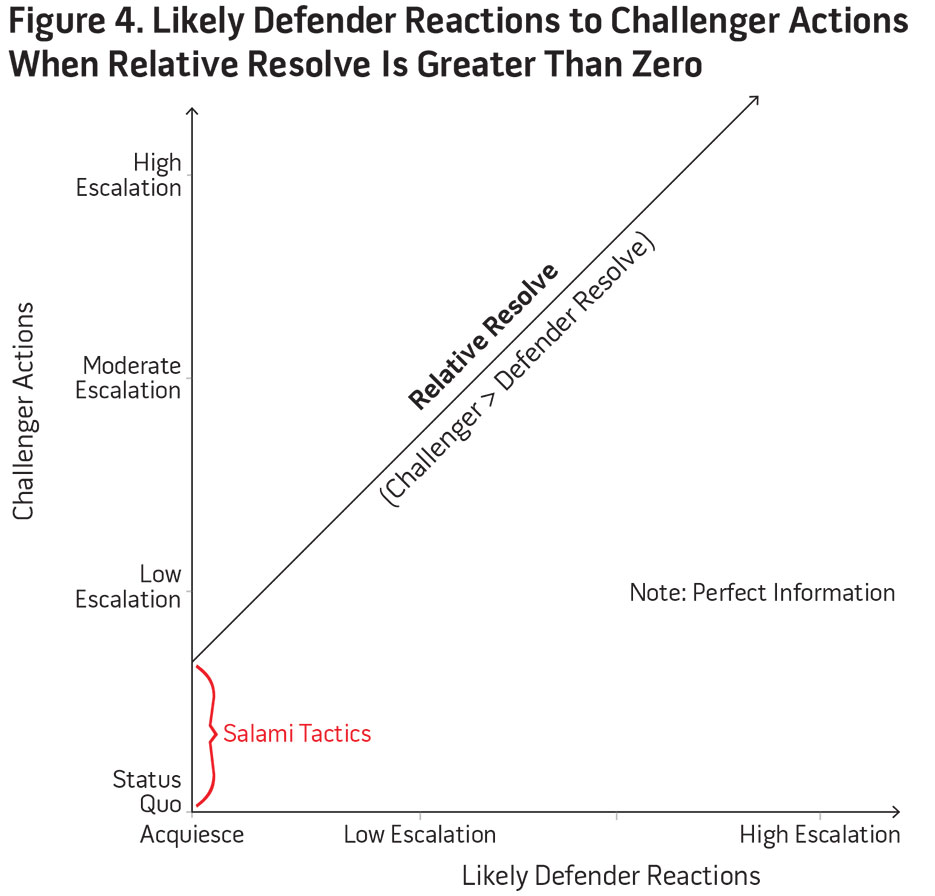
The previous escalation situations are based on two conditions: deliberate escalation decisions for instrumental purposes, that is, to gain some advantage; and having perfect information. There are other types of escalation and information levels that must be considered. For example, the concept of autonomous risk that some other outcome will occur is a result of uncertainty and unpredictability because actors cannot guarantee that a particular outcome will be realized.14 There is always a chance of accidental escalation because actors make mistakes.15
In addition to autonomous risk and accidental escalation, there is the risk of inadvertent escalation when intentional acts are mistakenly perceived as escalatory, “usually because they cross a threshold of intensity or scope in the conflict or confrontation that matters to the adversary but appears insignificant or is invisible to the party taking the action.”16 Adversaries often misunderstand each other’s intentions, even when accompanied by clear messaging. Often messages that are either sent or received are misdirected, badly formulated, contradictory, or absent altogether.17 Sometimes an actor resorts to bluffing to be perceived as more resolute than he actually is. Likewise, an actor may demonstrate his resolve through deliberate escalation for suggestive or reputational purposes as a form of signaling.18 Due to imperfect information, the escalation calculus for decisionmakers includes a zone of uncertainty when considering an escalation decision, as depicted in figure 5. Therefore, the greater the imperfect information and misperception, the more crisis stability decreases:19 “Ambiguity does not deter universally.”20
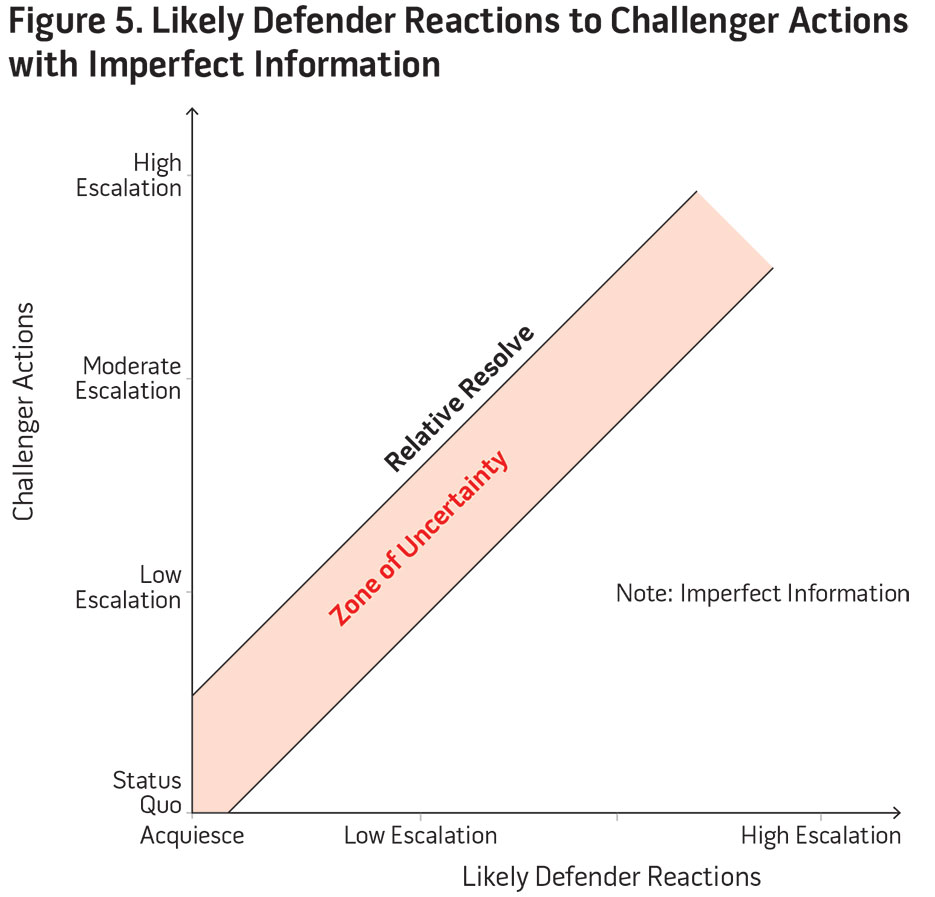
Survey questions are used in wargames to assess player perceptions at the end of each game move. To measure resolve, players are asked to assess a statement concerning each actor’s willingness to escalate. The data collected are subjective and attempt to measure something psychological, where “deterrence is like all other psychological variables: it will vary by person and condition.”21 Therefore, the results are not examined by comparing how one actor assesses his own resolve with how another actor assesses his because each personal scale could differ. But it is useful to measure the perceived relative resolve, that is, each actor’s resolve compared to his perceived resolve for his adversary or allies. However, a tendency does exist to perceive an adversary as more resolute than oneself. This inclination is a result of the difficulties of emulation, incomplete information, emotion, the limits of human cognition, and a variety of possible biases affecting perceptions.22
The use of two-sided wargames attempts to replicate environments of strategic crisis that allow players to make decisions based on their assessments of relative resolve. In assessing wargames, measures of relative resolve can help analysts explain why players escalated or acquiesced. Trends in relative resolve across moves can indicate whether players were successful in their deterrence strategies. Reasons for shifts in perceptions of resolve usually involve one or a combination of the three components of resolve: stakes, credible capabilities, and risk tolerance. While stakes and credible capabilities, such as a nation’s objectives and forces employed, can be identified more readily, identifying risk tolerance is particularly challenging as it is more of an inherent trait that characterizes individuals.
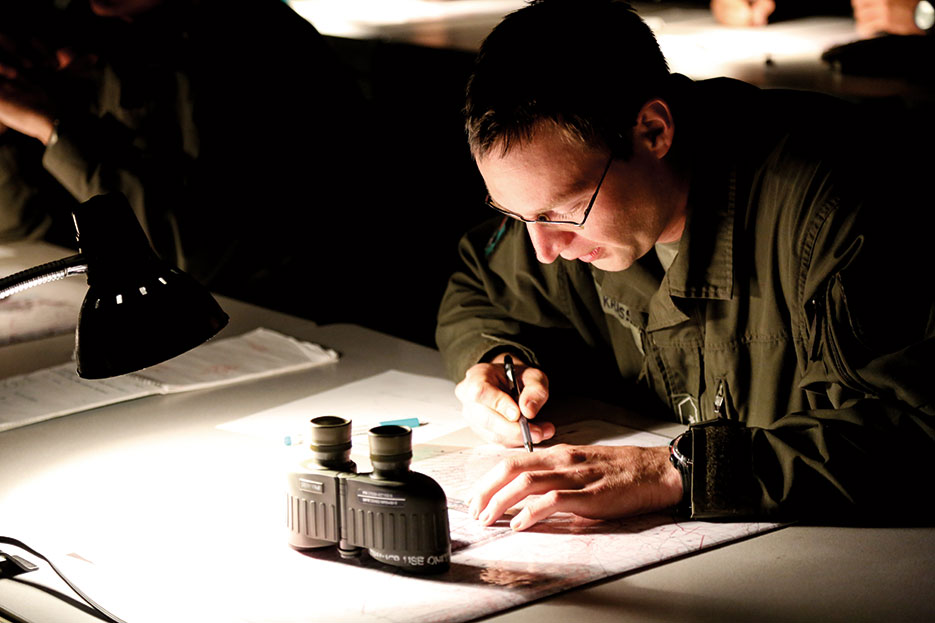
Austrian soldier plots points on map during exercise Combined Resolve II at Joint Multinational Readiness Center in Hohenfels, Germany, May 14, 2014 (DOD/Justin De Hoyos)
Perceptions of Risk Tolerance
Risk assessment takes into account both the probability and the consequences associated with a course of action. While the consequences could be benefits or costs, the probability concerns the likelihood that a course of action will result in those consequences. Risk management involves making decisions that balance risk costs with mission benefits.23 Risk tolerance involves a predisposition for aggressiveness and boldness. It usually remains constant, but risk tolerance may shift due to a change in domestic politics that pushes for riskier policies. Consider, for example, U.S. strategic decisionmaking following an unprovoked attack: “Domestic politics could force large changes in policy in a very short period of time. The White House, the Congress, and the Pentagon may have to pivot in a hurry, and use much more aggressive, risky steps to manage the problem. . . . [R]estraint may disappear overnight.”24
While it is common to ask players during wargames to assess risk, another approach attempts to assess risk tolerance through understanding the players’ comfort with uncertainty or imperfect information. An actor with a high risk tolerance may take more aggressive action with a large zone of uncertainty, as depicted in figure 5, despite imperfect information and a greater risk of inadvertent or accidental escalation. Additionally, an array of risk represents a range of options between doing too little (acquiescing) and doing too much.25 The larger the array of risk, the riskier it is to escalate because one must take larger, more dangerous steps toward the brink. The smaller the array of risk, the less risky it is to escalate because the steps toward the brink are smaller. Therefore, risk tolerance can be measured during wargames as a function of players’ comfort with ambiguity and the availability of escalation options. As players appear more comfortable with ambiguity and have more escalation options available, their risk tolerance seems higher.
Coalition Effects on Resolve
Building coalitions and working with allies can be difficult tasks. However, as Sir Winston Churchill famously stated, “There is at least one thing worse than fighting with allies, and that is to fight without them.” Fighting with a coalition has numerous benefits in the context of deterrence. It allows for risk-sharing, increases capabilities, and demonstrates higher stakes in the crisis. The concept of extended deterrence has been part of U.S. strategy since 1957, when Henry Kissinger realized the necessity of having allies surrounding an adversary and of minimizing the cost of their security by lessening dependence on local defenses.26 Extended deterrence, however, also has its disadvantages. For example, it may create a credibility problem, suggesting whether a state would risk annihilation for the sake of allies. This dilemma might explain why Japan would likely contemplate developing its own nuclear capability if it believed the United States would not consider a nuclear option in its defense.27
In addition to risk-sharing, some allies have higher risk tolerance, thereby increasing the overall risk to all partners in the alliance. Overall, building and maintaining a coalition requires a major effort and faces numerous challenges. While joint doctrine describes an alliance as having broad, long-term objectives and common interests,28 the diversity of stakes and interests among allies can be extensive. The defining feature of multiplayer games is coalitions, in which different countries align with one another. But coalitions are not static; they tend to be dynamic, changing over time.29 Learning about regional allies may be more important for deterrence strategies than any analysis of game theory or abstracted gaming practices.30
During a recent strategic deterrence wargame at the U.S. Naval War College, a moderate correlation occurred between the measures of U.S. resolve and the U.S. demonstration of commitment to its allies, as perceived by the adversary. When it appeared that U.S. forces were successful in assuring allies, the adversary perceptions of U.S. resolve increased. This correlation suggests a relationship may exist between the effectiveness of coalition-building and that of demonstrating resolve, potentially mitigating the risk of escalation. This finding reinforces the lessons of the Cold War, where the “politics of alliance were as important to deterrence as any other element.”31
Correlation, however, does not necessarily mean causation. There are numerous possible reasons for perceptions of both ally assurance and demonstrations of resolve. The likely cause may lie in one or a combination of the three components of resolve. For example, maintaining the integrity of the alliance, in itself, may add to the overall stakes in a conflict. Likewise, the combined capabilities of the alliance may add not only to the quantity of credible employment options available in a conflict but to the diversity as well. Finally, risk tolerance for an alliance, standing together rather than alone, would likely be formidable in a conflict. For this reason, game findings have helped inform planners on the critical role that maintaining alliance cohesion has in contingencies involving strategic deterrence of nuclear-capable adversaries.
Applying Wargaming Lessons
The use of wargaming at the U.S. Naval War College has provided a laboratory in which to examine strategic deterrence approaches. Because wargaming alone does not provide answers, the key to assessing deterrence lies with the ability to measure escalation and resolve as the espoused effects and inherent drivers of deterrence decisions. Breaking down resolve into the components of stakes, credible capabilities, and risk tolerance helps explain the motivations behind the escalation decisions made in a strategic deterrence wargaming environment. This, in turn, allows researchers to apply lessons to better understand the dynamics of real-world strategic challenges. These lessons inform operational plans and potentially influence policy decisions, such as those concerning forward-deployed forces, alliance agreements, and nuclear force posture.
While wargames provide general insights on strategic deterrence at the conceptual level, specific insights about adversaries and notional scenarios can be derived at the empirical, albeit classified, level. For example, in his recent article “Future Scenarios of Limited Nuclear Conflict,” Thomas Mahnken outlines five nuclear conflict scenarios with which to address an array of national security dilemmas:
While analyzing these problems may inform forward-based presence and force posture, they likewise help evaluate the effectiveness of extended nuclear deterrence that “may be more open to question in the context of today’s nuclear powers. It is worthwhile, then, to explore new approaches to enhance U.S. extended nuclear deterrence guarantees to allies.”32 Wargaming provides a method to explore these new approaches, exposes leaders to decisionmaking experience, and potentially helps them develop a rubric for strategic deterrence options.JFQ
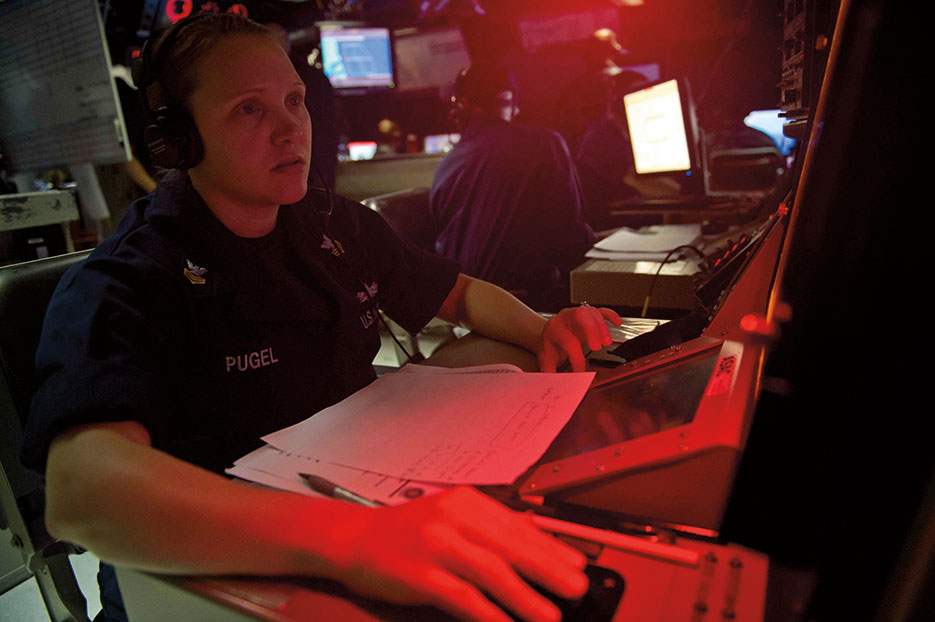
Sailor monitors subsurface contacts in combat information center aboard guided-missile destroyer USS Jason Dunham in Atlantic Ocean, as part of simulated wargames, May 19, 2014 (U.S. Navy/Derek Paumen)
Notes
1 Richard E. Neustadt and Ernest R. May, Thinking in Time: The Use of History for Decision Makers (New York: The Free Press, 1986), 10–14.
2 National Military Strategy 2015 (Washington, DC: The Joint Staff, June 2015), 10.
3 Joint Publication (JP) 3-0, Joint Operations (Washington, DC: The Joint Staff, August 11, 2011), GL-9.
4 Austin G. Long, Deterrence: From Cold War to Long War (Santa Monica, CA: RAND Project Air Force, 2008), 7.
5 Paul Bracken, The Second Nuclear Age: Strategy, Danger, and the New Power Politics (New York: St. Martin’s Press, 2013), 43.
6 Francis J. McHugh, Fundamentals of War Gaming (Newport, RI: U.S. Naval War College, 1966), 19.
7 Forrest E. Morgan et al., Dangerous Thresholds: Managing Escalation in the 21st Century (Santa Monica, CA: RAND Project Air Force, 2008), xiii.
8 Ibid., 8.
9 Thérèse Delpech, Nuclear Deterrence in the 21st Century: Lessons from the Cold War for a New Era of Strategic Piracy (Santa Monica, CA: RAND, 2012), 56.
10 Robert Powell, Nuclear Deterrence Theory: The Search for Credibility (Cambridge: Cambridge University Press, 1990), 53.
11 Ibid., 156–157.
12 Thomas C. Schelling, Arms and Influence (New Haven: Yale University Press, 1966), 66–67.
13 Powell, 91.
14 Glenn H. Snyder and Paul Diesing, Conflict among Nations: Bargaining, Decision Making, and System Structure in International Crises (Princeton: Princeton University Press, 1977), 210; quoted in Powell, 18.
15 Morgan et al., 26.
16 Ibid., 23.
17 Delpech, 18.
18 Morgan et al., 31–33.
19 Powell, 161.
20 Delpech, 48.
21 Bracken, 70.
22 Long, 56.
23 JP 3-0, III-14.
24 Bracken, 223.
25 Powell, 99.
26 Henry A. Kissinger, Nuclear Weapons and Foreign Policy (New York: Harper, 1957), 239; Delpech, 29.
27 Bracken, 240.
28 JP 1-02, Department of Defense Dictionary of Military and Associated Terms (Washington, DC: The Joint Staff, November 8, 2010, as amended through June 15, 2015), 11.
29 Bracken, 241–242.
30 Delpech, 49.
31 Long, 14.
32 Thomas G. Mahnken, “Future Scenarios of Limited Nuclear Conflict,” in On Limited Nuclear War in the 21stCentury, ed. Jeffrey A. Larsen and Kerry M. Kartchner (Stanford: Stanford University Press, 2014), 143.